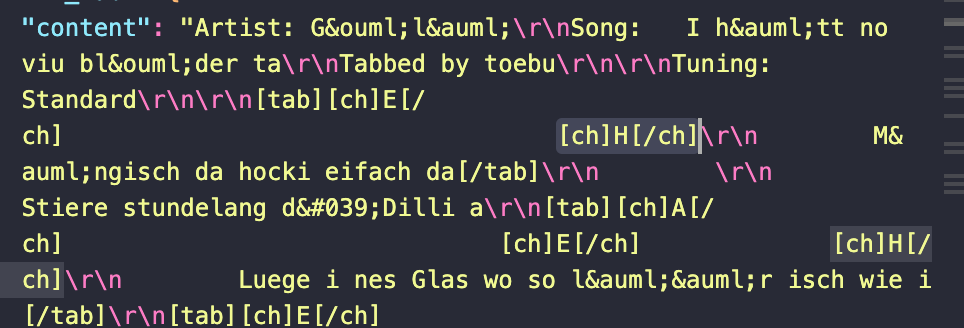I received a strange bug report on Penultimate Guitar where the Next.js rendering would fail completely on certain songs.
The Error
The type error was being triggered by a chord component, where the key was undefined. The chords are pulled from Ultimate Guitar, so I inspected the JSON payload from the original source.

Why the hell is there a [ch]H[/ch] chord in there? That's definitely the cause as I never accounted for non-existent keys. Looking at Ultimate Guitar, it renders as a B chord.

Huh?
An aside on Ultimate Guitar HTML
The way Ultimate Guitar handles data is bizarre. It passes a static dehydrated HTML page to the client. The data payload is in the HTML as well, but instead of being contained in a script tag it's a giant JSON payload in an escaped string within an attribute of a random div
One Google Search Later
Germany and the Netherlands ha(d/ve) their own musical key notation that include(d/s) a H chord. This site claims it ended in "1994/1995", though I've seen other sources claim its still taught this way. This comes as an artifact of the bizarre history Western music notation, which is a problem I seem to keep running into recently in my attempts to learn more about music theory.
I learned in music school that the chord is called "B" (like in the rest of the world), but the note is called "H" (eg. the C Major scale would be C, D, E, F, G, A, H, C).
TobTobXX, who reported the bug
Western Music's Stupid Origins
Western music is based on ecclesiastic modes used in church in the early Middle Ages, which only used the diatonic notes of the C scale (natural notes). The musical notation systems of the time reflected this, not accounting for notes outside of the C scale. When sharps and flats later came into more common use, the existing notation systems needed a way to distinguish them from the natural notes they sat between.
This problem first arose with B natural and B flat, according to the Encyclopedia Britannica. The first method of distinguishing B from B flat was using two different forms of the lowercase "b" character:

Niecks, Frederick. “The Flat, Sharp, and Natural. A Historical Sketch.” Proceedings of the Musical Association, vol. 16, 1889, pp. 79–100.
Somewhere along the line in Germany, monks transcribing these square and round "b" characters confused the squared "b" for "h", and this was later assumed to be intentional. "H" became a convention for writing B natural, while the "b" character remained convention for writing B flat. "B" and "b" became amalgamated, both coming to represent modern B flat.
In the rest of the world, this "H" note didn't catch on.
In time, notation for sharp and flat notes other than B flat was needed. This use of square and round "b" to denote B and B flat eventually evolved into our modern notation for indicating natural and non-natural, accidentals. ♭ comes from the round "b", while ♯ and ♮ come from the square "b".
Somehow, Germany still hasn't fully corrected this mistake, continuing to use "H" to represent B natural and many places. Including Ultimate Guitar. Ugh.
Resolution
I don't love dealing with problems caused by the whims of millenia dead monks, but this was an interesting rabbit hole to fall into. The issue has since been patched, and I look forward to my mistakes ruining someone's day in 3023.

An aside on The Flat, Sharp, and Natural. A Historical Sketch
When I first copied the text from the article, it copied that "square b" as a "h". Funny that modern OCR technology makes the same mistakes at 1000 year old monks.
The first known writer who distinguished between b natural and b flat was Odo of Clugny, who died in 942 ; the b natural being indicated by a square b (h), the b flat by a round b (b)
It was also a pain in the ass to find a copy of that article. It's mostly found on paywalled academic sites despite the article definitely being out of copyright. Luckily the Internet Archive has a copy.